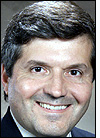Health-care RFID technology provider Radianse has teamed up with Patient Care Technology Systems (PCTS) to offer an RFID-based solution for hospital workflow. The two companies say their package provides a greater level of functionality than other RFID or wireless solutions.
The package includes PCTS’ Amelior automatic patient- and asset-tracking software, integrated with Radianse’s real-time indoor positioning solutions.
For two years, Radianse has been offering hospitals an active RFID patient- and asset-tracking system known as an indoor positioning solution (IPS). The IPS included tags, readers and networking software. By integrating with PCTS, says John Pantano, vice president of marketing, Radianse can take its services beyond simple identification and tracking. “What hospitals are looking for is to make more sense of the data,” he says.
The IPS system consists of active 433 MHz tags that can be attached to assets, patient bracelets, or employee badges. RFID receivers—small boxes the size of a doorbell, Pantano explains—are mounted on walls throughout the hospital. The receivers plug into the hospital’s LAN and relay data to a server onto a wireless network.
The system provides room-level accuracy, allowing hospitals to know where patients are in real-time, and where assets are—such as small electronic devices that can get wrapped up in bed sheets headed for the laundry room. In the event that such an item goes down the laundry chute, for example, a receiver in the laundry room will receive a transmission from the device, and an alert can be sent to hospital staff via page or e-mail.
While Radianse’s product addresses hospitals’ basic need to identify and locate assets, the partnership adds another level of functionality, allowing hospitals to take advantage of all the data the RFID system captures, says PCTS director of research and development, Cory Wagner.
With the integrated solution, Wagner says, data from the RFID system can trigger responses, such as notifying the staff to prepare a patient room after a patient is tracked leaving one department for another in the process of hearing toward that room. That communication can be sent to the appropriate staff members via pager as soon as the RFID system confirms the patient is on the move.
The hospital can also use the data for analysis of its operations and practices. For instance, administrators can access reports to see the average work time for specific tasks, which could help streamline and improve workflows.
The PCTS software can incorporate data from various technologies, including infrared sensors, Wi-Fi access points and RFID, and can combine all three in the event that a hospital is using infrared in one department and another wireless technology in another. “We’re not hawking one kind of technology,” Wagner says.
However, most hospital customers come to PCTS with a “virgin environment” (no tracking technology), Wagner says. “They tend to be looking for a place to get started. Locating is a good place to start, but if they really want to maximize their investment, they need to go beyond locating patients,” he said.



